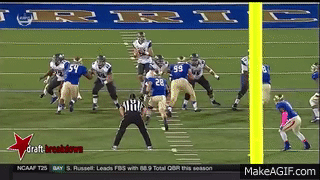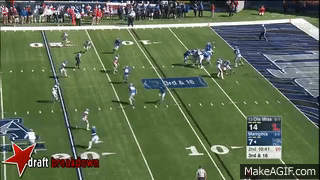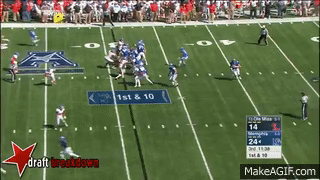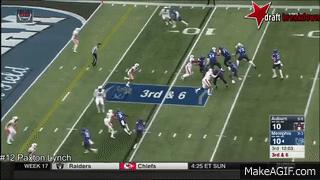Even for most who closely follow the draft on a year long basis, Paxton Lynch was little more than a placeholder at quarterback for the University of Memphis. It didn't take long for Lynch to go form generic to name brand, as he put on a torrent of guady performances from the second week of the season onward.
Standing at 6'7" and 244 lbs., Lynch's physical attributes are striking. Perhaps even more striking are his 2015 season statistics. Lynch threw 28 touchdowns to only four interceptions on the year, including a seven touchdown performance against SMU - a game where he only attempted 14 passes. On the surface, Lynch's numbers appear befitting of top 10 consideration, but recent mock drafts and analysis have him as a late first or second round selection. So where is the disconnect between production and prospectus?
Strengths:
Perhaps the first thing any quarterback must answer is whether or not he meets the physical benchmarks required of the position. In recent years, teams have been trying to stretch the standards in light of the successes of less-than-ideal measurables of players like Drew Brees and Russell Wilson, but no such consessions need to be made for Lynch. As mentioned, Lynch has the height and weight of an NBA small forward, introducing a different sect of skepticism.
The most recent examples of quarterbacks possessing similar physical traits are Ryan Mallett and Brock Osweiler, both of whom started at some point during the 2015 NFL season. With such a small sampling, there is some skepticism regarding Lynch's size, but when reviewing his 2015 season, it's clear that he uses it to his advantage.

On this play against Tulsa, it's clear to see how Lynch has no trouble seeing over his offensive line. Despite not having a complete over the top release, Lynch has little trouble finding passing lanes, either.
Another area where Lynch uses his size to his advantage comes when rolling out as a passer (and runner), where he shares more with someone like Osweiler and less with Mallett. Lynch is very comfortable using his legs to both escape pressure and pick up valuable yardage as a rusher.

In a game against Ole Miss' atheltic SEC defense, Lynch was able to consistently make and extend plays under pressure.
In fact, Lynch's game against Ole Miss is the basis of much of his first round consideration. Lynch showed both poise and leadership, leading his team to victory against a then top 15 opponent from an early 14-0 deficit. At his best, Lynch shows he can make pin point throws with accuracy and velocity.

Weaknesses:
Although the argument for Lynch in the first round is a strong one (especially for those quarterback needy teams), there is equal merit as to why he should take a draft day tumble.
First, Lynch played in an offense which is arguably the biggest departure to an NFL scheme compared to the other first round viable quarterbacks in this class. Under head football coach Justin Fuente - who will replace the reting Frank Beamer at Virginia Tech - Lynch made comparitvely less full field reads to someone like Jared Goff, who also played in an up-tempo spread system at California. There shouldn't be an assumption that Lynch can't learn a more NFL tailored system, but he is perhaps the most raw prospect amongst his peers.
Physically, Lynch will still present an enigma for many scouts. At 6'7", the success rate for quarterbacks that size is tough to gauge given the aforementioned limited sample size. While a capable mover and athlete who turned in respectable combine numbers, Lynch has predictably slower than ideal feet in the pocket. He also has the habit of stopping short on roll outs, which can be a very dangerous thing in the NFL against back side pursuit. Lastly, Lynch possesses a less than ideal release speed that can become elongated on more difficult throws, giving the defense more time to react to his passes.

Lastly, Lynch doesn't consistently display his strengths on a game by game basis. For all the strengths he displayed against Ole Miss and throughout the early collegiate regular season, much of his mystique began to wane as the season carried on. In his final game against Auburn, where he completed only 43 percent of his passes for 106 yards and one interception, Lynch lacked conistent accuracy and sound decision making all game long.
Overview:
Ultimately, teams are well within their right to be excited about Lynch because, after all, there is more to like than dislike about the former Memphis Tiger. Early season excitement was well warranted, as is the skepticism brought about by his late season melt down. Any team ending up with him understands the clay their getting, and will need to mold him into the player he can be, but isn't yet.
The Los Angeles Rams, New York Jets, Arizona Cardinals, and Denver Broncos are all logical destinations for Lynch. For the Broncos, it would be tough to pass up a player who shares so much with the recently departed Brock Osweiler. In many respects, Lynch is a better prospect than Osweiler was coming out of Arizona State - taken in the second round. Wherever he ends up, Lynch would be best served as either sitting the majority of his rookie year, or playing on a team not needing him to carry the offense early on. There's a lot of promise in Lynch, but he'll have to be given the opportunity to grow as an NFL quarterback.










































